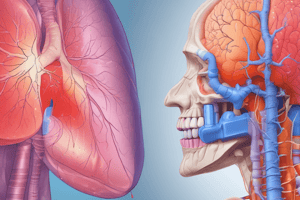Podcast
Questions and Answers
What is oxyhemoglobin?
What is oxyhemoglobin?
- Hemoglobin that is fully saturated with oxygen
- The combination of hemoglobin and oxygen (correct)
- Hemoglobin that is partially saturated with oxygen
- Hemoglobin that has released oxygen
What happens to hemoglobin's shape as oxygen binds to it?
What happens to hemoglobin's shape as oxygen binds to it?
- The shape remains the same
- It releases all of its oxygen
- It changes shape, increasing attraction for oxygen (correct)
- It becomes less attractive for oxygen
What does a fully saturated hemoglobin mean?
What does a fully saturated hemoglobin mean?
- Hemoglobin has no affinity for oxygen
- All four heme groups carry oxygen (correct)
- All hemoglobin molecules are deoxygenated
- Only one heme group carries oxygen
Which factor influences hemoglobin saturation apart from PO2?
Which factor influences hemoglobin saturation apart from PO2?
In arterial blood, what is the saturation level of hemoglobin?
In arterial blood, what is the saturation level of hemoglobin?
What is venous reserve referring to?
What is venous reserve referring to?
How many oxygen molecules can each hemoglobin molecule transport?
How many oxygen molecules can each hemoglobin molecule transport?
What can cause a decrease in the attraction of hemoglobin for oxygen?
What can cause a decrease in the attraction of hemoglobin for oxygen?
'Venous reserve' refers to the:
'Venous reserve' refers to the:
'Partially saturated' hemoglobin means:
'Partially saturated' hemoglobin means:
Flashcards are hidden until you start studying
Study Notes
Respiratory System
- Alveolar sacs contain clusters of alveoli (~300 million) which make up most of lung volume and are the sites of actual gas exchange.
Respiratory Zone Structures
- Alveoli are responsible for gas exchange
- Alveolar ducts connect to respiratory bronchioles
- Respiratory bronchioles lead to terminal bronchioles
Respiratory Membrane
- Consists of a single layer of squamous epithelium and scattered cuboidal alveolar cells that secrete surfactant and antimicrobial proteins
- Acts as a blood-air barrier, allowing gas exchange by simple diffusion
Lungs and Pleurae
- Lungs flank the mediastinum in the thoracic cavity
- Root: site of vascular and bronchial attachment to the mediastinum
- Costal surface: surfaces in close contact with ribs
- Apex: superior tip, deep to the clavicle
- Base: inferior surface that rests on the diaphragm
Pulmonary Ventilation
- Inspiration: active process that occurs during vigorous exercise or in people with COPD
- Expiration: passive process that occurs when inspiratory muscles relax, thoracic cavity volume decreases, and lungs recoil
- Intrapulmonary pressure (Ppul) increases, causing air to flow out of the lungs
Gas Exchange
- Occurs between lungs and blood, as well as between blood and tissues
- External respiration: diffusion of gases between blood and lungs
- Internal respiration: diffusion of gases between blood and tissues
Pulmonary Function Tests
- Forced vital capacity (FVC): amount of gas forcibly expelled after taking a deep breath
- Forced expiratory volume (FEV): amount of gas expelled during a specific time interval of FVC
- Patients with obstructive disease exhale less than 80% in 1st second, while those with restrictive disease exhale 80% or more, even with reduced FVC
Alveolar Ventilation
- Minute ventilation: total amount of gas that flows into or out of the respiratory tract in 1 minute
- Alveolar ventilation rate (AVR): flow of gases into and out of alveoli during a particular time
- Better indicator of effective ventilation as it accounts for the anatomical dead space
Gas Exchange Laws
- Dalton's Law: each gas will dissolve in the liquid in proportion to its partial pressure
- Henry's Law: amount of each gas that dissolves depends on solubility, temperature, and other factors
External Respiration
- Involves the exchange of O2 and CO2 across respiratory membranes
- Influenced by pressure gradients and gas solubilities
- Thickness and surface area of respiratory membrane affect the rate of gas exchange
Oxygen Transport
- Association of oxygen and hemoglobin: each Hgb can transport four oxygen molecules
- Oxyhemoglobin (HgbO2): hemoglobin-O2 combination
- Deoxyhemoglobin (HHb): hemoglobin that has released O2
Oxygen Binding and Release
- Loading and unloading of O2 is facilitated by a change in shape of Hgb
- Factors that influence hemoglobin saturation: PO2, temperature, blood pH, PCO2, and concentration of BPG
Studying That Suits You
Use AI to generate personalized quizzes and flashcards to suit your learning preferences.




